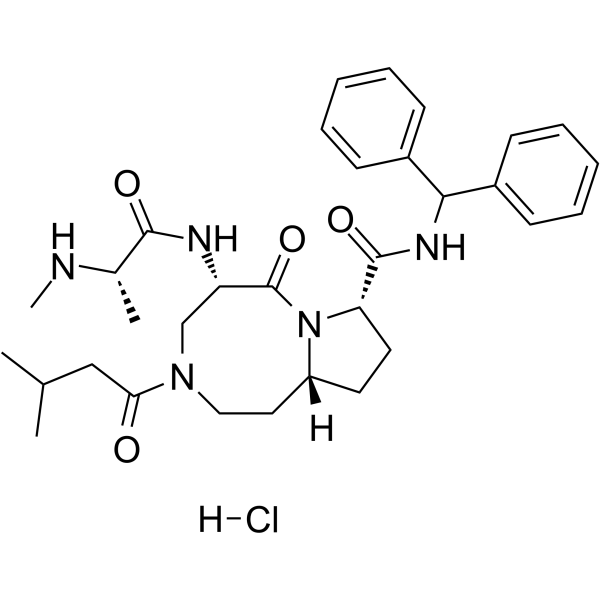
Xevinapant (AT-406) hydrochloride is a potent and orally bioavailable Smac mimetic and an antagonist of the inhibitor of apoptosis proteins (IAPs). Xevinapant hydrochloride binds to XIAP, cIAP1, and cIAP2 proteins with Kis of 66.4, 1.9, and 5.1 nM, respectively. Xevinapant hydrochloride effectively antagonizes XIAP BIR3 protein in a cell-free functional assay, induces rapid degradation of cellular cIAP1 protein, and inhibits cancer cell growth in various human cancer cell lines. Xevinapant hydrochloride is highly effective in induction of apoptosis in xenograft tumors.
| Molecular Weight | 598.18 |
| CAS Number | 1071992-57-8 |
| Solubility (25°C) | DMSO 100 mg/mL |
| Storage | -20°C, protect from light, dry, sealed |
| Species | Mouse | Rat | Rabbit | Guinea pig | Hamster | Dog |
| Weight (kg) | 0.02 | 0.15 | 1.8 | 0.4 | 0.08 | 10 |
| Body Surface Area (m2) | 0.007 | 0.025 | 0.15 | 0.05 | 0.02 | 0.5 |
| Km factor | 3 | 6 | 12 | 8 | 5 | 20 |
| Animal A (mg/kg) = Animal B (mg/kg) multiplied by | Animal B Km |
| Animal A Km |
For example, to modify the dose of Compound A used for a mouse (20 mg/kg) to a dose based on the BSA for a rat, multiply 20 mg/kg by the Km factor for a mouse and then divide by the Km factor for a rat. This calculation results in a rat equivalent dose for Compound A of 10 mg/kg.
| Related IAP Products |
|---|
| Sanggenon G
Sanggenon G is a cell-permeable and potent inhibitor of X-linked inhibitor of apoptosis protein (XIAP). |
| TD-1092
TD-1092 is a pan-inhibitor of apoptosis (IAP) degrader with two different types of E3 ligase conjugates, IAP and CRBN, that induces proteasomal degradation of cIAP2 and XIAP in a CRBN-dependent manner. TD1092 also activates apoptotic proteases (apoptosis 3/7) and leads to apoptosis by promoting IAP degradation. In addition, TD1092 also blocks the TNFα-mediated NF-κB signaling pathway and inhibits the phosphorylation of IKK, IkBα, p65, and p38. TD1092 can be used as a PROTAC for cancer research. |
| LBW242
LBW242, a 3-mer and Smac mimetic, is a potent and orally active proapoptotic IAP inhibitor. LBW242 shows effects on mutant FLT3-expressing cells. LBW242 has activity against multiple myeloma, and potentiates TRAIL- and anticancer agent-mediated cell death of ovarian cancer cells. |
| UC-112
UC-112 is a novel potent IAP(Inhibitor of apoptosis) inhibitor. UC-112 potently inhibit cell growth in two human melanoma (A375 and M14) and two human prostate (PC-3 and DU145) cancer cell lines(IC50=0.7-3.4 uM). |
| SBP-0636457
SBP-0636457 (SB1-0636457) is a SMAC mimetic, and as an IAP antagonist. SBP-0636457 binds to the BIR-domains of the IAP proteins, with a Ki of 0.27 μM. SBP-0636457 can be used for the research of solid tumors and hematologic cancers. |


Products are for research use only. Not for human use. We do not sell to patients.
© Copyright 2010-2023 AbMole BioScience. All Rights Reserved.
